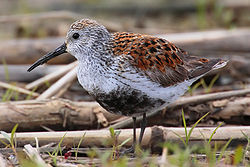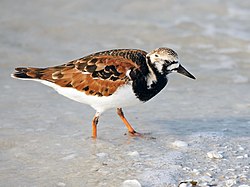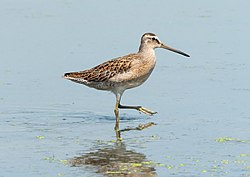Sandpiper
Sandpipers are a large family of waders or shorebirds, the Scolopacidae. They include many species called sandpipers, as well as those called by names such as curlew and snipe.
| Sandpipers | |
|---|---|

| |
| Dunlin (Calidris alpina) | |
| Scientific classification | |
| Kingdom: | |
| Phylum: | |
| Class: | |
| Subclass: | |
| Infraclass: | |
| Order: | |
| Suborder: | Scolopaci
|
| Family: | Scolopacidae Rafinesque, 1815
|
Sandpipers are small birds with a longish pointed beak, and usually a rounded shape. Most species eat small invertebrates picked out of the mud, sand or soil. Different lengths of bills allow different species to feed in the same habitat on the coast without direct competition for food.
Sandpipers have long legs, and narrow wings. Most species have a narrow bill, but otherwise the form and length are quite variable. They are small to medium sized birds, measuring 12 to 66 cm (4.7–26.0 in) cm in length. The bills are sensitive, allowing the birds to feel the mud and sand as they probe for food. They generally have dull plumage, with cryptic brown, grey, or streaked patterns, although some display brighter colours during the breeding season.[1]
Most species nest in open areas, and defend their territories with aerial displays. The nest itself is a simple scrape in the ground, in which the bird usually lays three or four eggs. The young of most species are precocial.[1]
Sandpiper Media
References
- ↑ 1.0 1.1 Harrison, Colin J.O. (1991). Forshaw, Joseph (ed.). Encyclopaedia of Animals: Birds. London: Merehurst Press. pp. 103–105. ISBN 1-85391-186-0.









